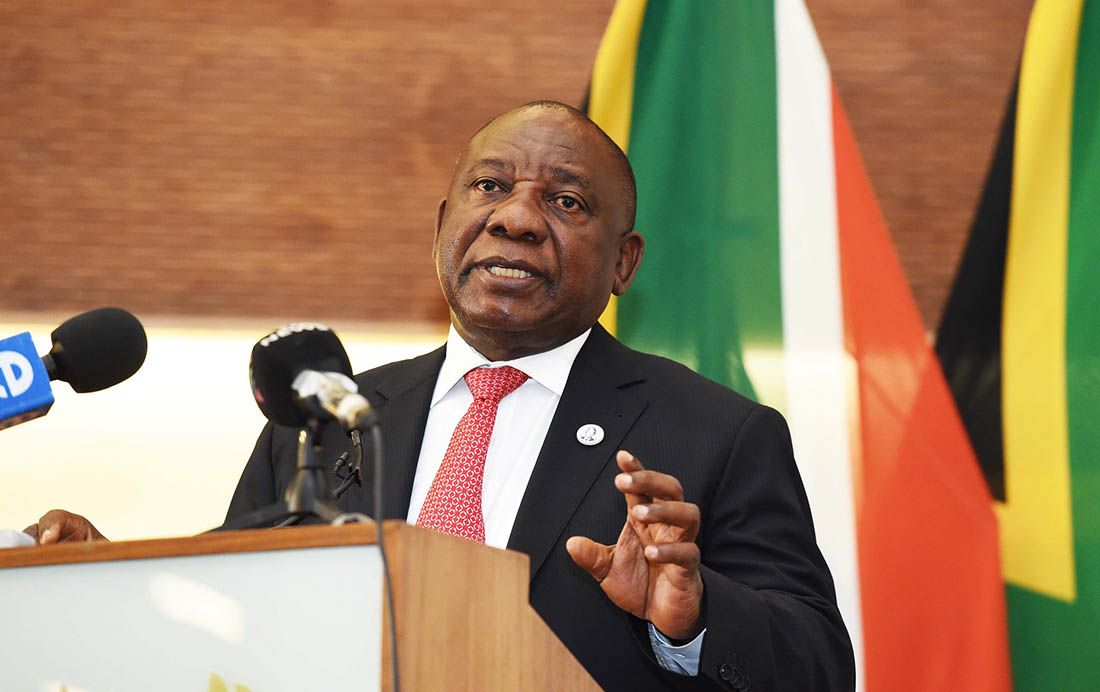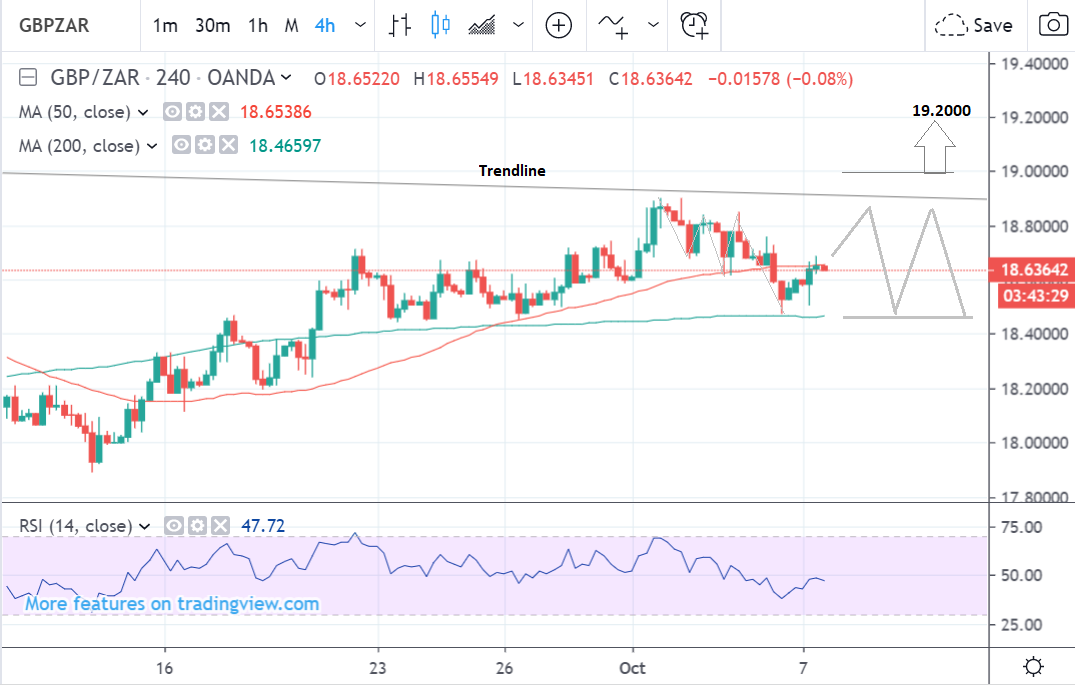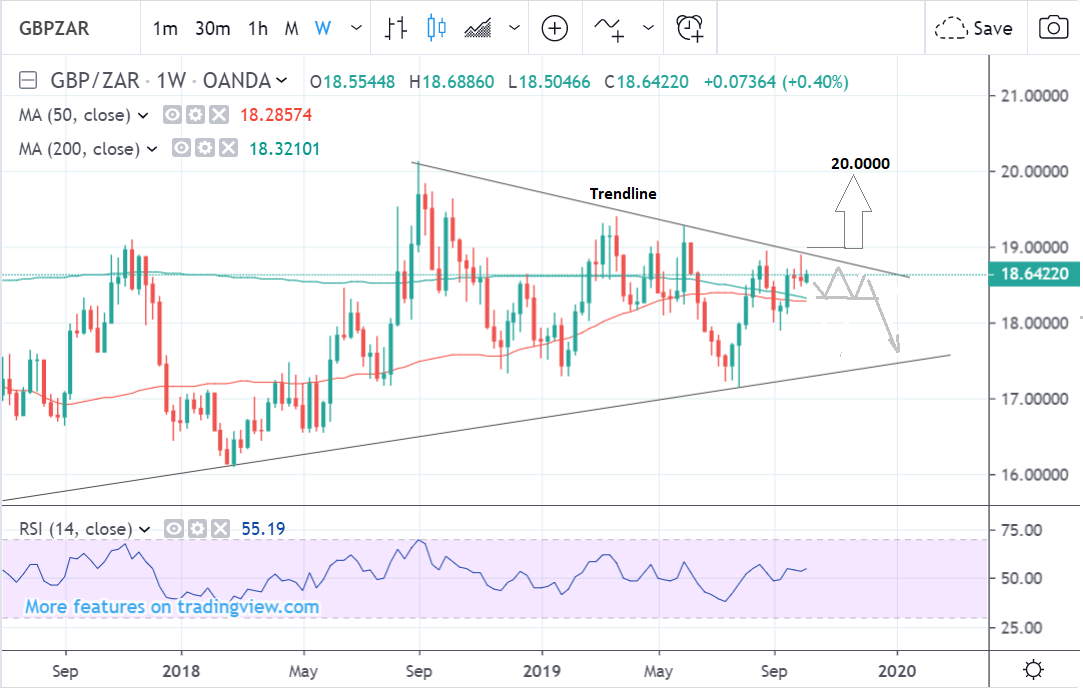Pound's Rally vs. Rand Now Subject to Break Above Technical Trendline

Image © Government of South Africa, reproduced under CC licensing
- GBP pulls back after touching major trendline.
- More upside requires break of 19.0 threshold.
- ZAR to be driven by risk appetite, GBP Brexit.
The Pound-to-South African Rand exchange rate is trading at around 18.66 at the time of writing, up 0.40% so far this week, but studies of the charts suggest the pair may start consolidating beneath the tough resistance of a major trendline.
The 4hr chart - used to determine the short-term outlook which includes the coming week - shows the pair running up against resistance from a long-term trendline before falling back down.
There is a strong layer of support just under the current level of the exchange rate, at around 18.40, and this could form the basis of a floor from which the pair could then rise and continue its range-bound consolidation.
Only a clear break above the trendline and 19.00 level would confirm a continuation higher to an upside target at 19.20.

Above: Pound-to-Rand rate shown at hourly intervals.
The daily chart shows how the pair has run up and touched the trendline on multiple occasions before falling back down.
The most recent occasion was at the October 02 highs. This was followed by a pull-back, which has almost reached support from the 50 and 200-day moving-averages at 18.40.
These are likely to prop up the exchange rate and see the pair consolidate in a sideways range beneath the trendline.
There is also the possibility of a breakout higher confirmed by a move above 19.00. Such a move would then probably rally up to resistance at 19.50.
The daily chart is used to give us an indication of the outlook for the medium-term, defined as the next week to a month ahead.

Above: Pound-to-Rand rate shown at 4-hour intervals.
The weekly chart shows how the pair remains capped by the long-term trendline and there is a risk this will continue.
In such a scenario it is likely to trend sideways between the major 50 and 200-week moving averages (MA) at 18.28 and 18.32 and the trendline above.
A break clearly above 19.00 would provide confirmation for a bullish breakout to a target at 20.00.
The weekly chart is used to give us an indication of the outlook for the long-term, defined as the next few months.

Above: Pound-to-Rand rate shown at weekly intervals.
AA
The South African (SA) Rand: What to Watch
The main drivers of the South African (SA) Rand in the week ahead are likely to be global risk trends, the value of the U.S. Dollar - to which the Rand is negatively correlated - and SA manufacturing and mining data because of the clues it'll provide on the growth outlook for the third quarter.
As an emerging market currency, the SA Rand tends to be sensitive to global risk appetite, falling when investor risk aversion increases and rising when risk appetite increases. The main driver of risk trends in the near-term is likely to be U.S.-China trade talks scheduled to begin on Thursday.
Initial optimism came from the fact that both sides arguably have more of an incentive to broker a deal than in previous talks. The U.S, presidential elections in 2020 are getting closer, increasing the pressure on Trump to do a deal to both protect his political heartland from Chinese tariffs and provide him with a ‘victory trophy’ to show off.
The Chinese may feel increased pressure to do a deal so as to counter continually decreasing growth. Yet this initial optimism has given way to pessimism after China said it wanted to narrow the scope of discussions to not include certain issues such as intellectual property, state subsidies and technology transferal.
The problem is that these are all areas the U.S. would want to cover as part of a comprehensive trade deal. U.S. President Donald Trump also recently said that he was not interested in doing a deal that was anything less than “100%”. The exclusion of key areas of a potential deal have increased the risk that the talks will fail, which would have a negative impact on the Rand.
“If the deal is not going to be 100% for us, then we’re not going to make it,” said Trump last Friday.
The main driver of the Dollar this week is inflation data out on Thursday. If the result is lower-than-expected it could fuel expectations of further Federal Reserve (Fed) rate cuts, which would weaken the Dollar and lift the Rand.
On the domestic data front, the main releases for the Rand are mining production and manufacturing output on Thursday. These could provide an insight into Q3 growth which might influence the Rand.
Of mining production, which is out at 12.30, ABSA says, “We forecast mining production to rise slightly by 0.1% m/m sa in August. However, as a result of base effects, year-on-year growth is likely to fall in the same month.”
Of manufacturing output, out at 14.30 they say, “Manufacturing production is likely to decline in August, partly as payback from the inventory build-up in motor manufacturing in July.
Recent PMI data was soft leading to growth concerns regarding the future, however, these are partly dismissed by Worthington.
“While the PMI data clearly point to soft growth momentum in Q3, we caution that they can sometimes diverge from official output data. We will, therefore, be looking for more clues on Q3 19 growth from the August manufacturing and mining output data due out next week,” says the ABSA analyst.
AA
The Pound: What to Watch
Brexit news will continue to dominate the Pound in the week ahead, whilst on the hard data front industrial and manufacturing production are the main releases along with the second estimate of Q2 GDP.
From a Brexit standpoint, the main focus will be on whether the UK and EU can strike a deal or at least a semblance of a deal - if they can the Pound could rise strongly. Dominic Cummings, a leading force behind the UK's Brexit strategy, has reportedly told aides that if the EU do not strike a compromise and agree to a new plan this week then the UK will be leaving without a deal.
The stakes are high, particularly as there is very little insight into how Prime Minister Boris Johnson intends to exit the EU without a deal on October 31.
According to government papers submitted to a Scottish court on Friday, Johnson will send a letter to the European Union asking for a Brexit delay if no divorce deal has been agreed by October 19. This means the Government intends to abide by the Benn Act which forces the Prime Minister to seek a Brexit extension if a deal has not been passed by parliament on October 19.
However, the British Pound actually went lower on the day as Government sources maintained that while they intend to follow the law, they will still not seek a delay. Steve Baker, the Conservative MP who heads up the party's Eurosceptic European Research Group responded to the government's court papers saying: "a source confirms all this means is that Government will obey the law. It does not mean we will extend. It does not mean we will stay in the EU beyond Oct 31. We will leave."
The UK recently submitted an alternative proposal to solve the problem of the Irish 'backstop' but the initial reaction of leading EU Brexit negotiators and stakeholders was not very positive and suggests the two sides were a long way from meeting in the middle.
Leo Varadkar, the prime minister of Ireland, said the UK’s present proposals “do not form the basis for deeper negotiations.”
The EU's chief Brexit negotiator Michel Barnier said, “there’s improvement...we are not there yet,” but privately was concerned about the proposal’s custom’s checks on the island of Ireland, a red-line for the EU.
Guy Verhofstadt, who heads up the EU Parliament's Brexit oversight committee commented that the proposals were “not positive in that we don’t think really there are the safeguards that Ireland needs.”
The proposal was however well-received by the government’s own party, however, including leading Brexiteers on the one hand and rebel Tory independents on the other. We noted that there is a decent chance the Government could win a majority were they to present a deal based on their latest plans, and this is an all-out positive development for Sterling.
A deal still looks to be some way off however as the further the government moves to meet the demands of the EU, who basically want a customs union in Ireland, the more it will alienate the ERG and DUP, without whose support it has no chance of getting the deal approved by Parliament.
This may overall lead to further pressure on the Pound in the week ahead.
Turning to the economic data, investors will be closely watching industrial and manufacturing data, which are both expected to show a -0.1% result in August from 0.1% and 0.3% respectively in July, when released on Thursday and 9.30 BST.
A combination of Brexit uncertainty and the global manufacturing slowdown have started to show up in British economic data and the recent Services PMI report said there was a heightened chance of a technical recession happening in the UK.
If the results show a deeper-than-expected contraction in the data the Pound will probably weaken.
Q2 GDP is expected to remain unrevised for its second estimate, with the quarterly reading to continue to show 0.0% growth, yearly 1.3% and monthly 0.3%.
If results are revised down the Pound will follow suit.
Time to move your money? Get 3-5% more currency than your bank would offer by using the services of foreign exchange specialists at RationalFX. A specialist broker can deliver you an exchange rate closer to the real market rate, thereby saving you substantial quantities of currency. Find out more here.
* Advertisement





